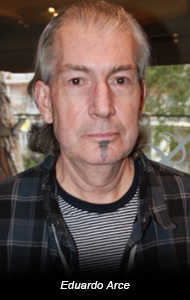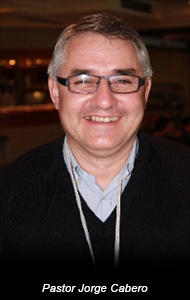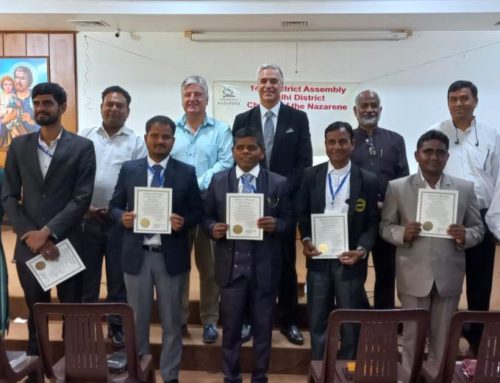Seville, Spain
 Standing at the bus stop in his neighborhood, Eduardo Arce struck up a conversation with Estela, the wife of Nazarene pastor Jorge Cabero. After this encounter, Jorge got in touch with Arce and they met for coffee. Jorge then invited Arce to church and he’s been attending for the past few years.
Standing at the bus stop in his neighborhood, Eduardo Arce struck up a conversation with Estela, the wife of Nazarene pastor Jorge Cabero. After this encounter, Jorge got in touch with Arce and they met for coffee. Jorge then invited Arce to church and he’s been attending for the past few years.
It’s these intentional, personal interactions with local Spanish people that are attracting them to the local Nazarene church in Seville.
The congregation – one quarter of which is native Spanish – is bucking a trend exhibited by other Protestant churches in Spain that often draws immigrants but fails to attract the Spanish (source: http://en.wikipedia.org/wiki/Religion_in_Spain). The Seville church’s involvement of Spanish people rises to one-third when those who are involved in community ministries of the church, such as home groups, are counted.
Jorge credits his church’s comparative success in reaching the Spanish to two things: the members don’t perceive one another as immigrants or natives but simply as brothers and sisters, and the congregation has taken an active concern in building intentional relationships with Spanish people.
“We don’t have a formula,” said Fran Tomas Martin, a Spanish person who attends the church and serves as the Nazarene Missions International president. “The formula is in the Bible, the formula is love. We’re just following Christ’s command to go and make disciples. That’s it.”
Spain churches have historically exhibited an attitude pervasive to Spanish culture that has also permeated the church: Immigrants and native Spanish don’t mix, according to Martin and Arce.
For years Nazarene churches in Spain have attracted immigrants native to countries in Central and South America, such as Peru, Ecuador, Bolivia, and Nicaragua. Nazarene missionary Joshua Herndon said many new members were already Nazarenes in their home country, so actual conversions are probably few.
“We’ve been working the past three years to encourage our churches to build relationships with the Spanish,” Herndon said. “Overall, it hasn’t gone very well. Many of our churches haven’t been able to get outside of the church culture.”
Jorge agrees.
“The number of times the church leaves and goes out and does stuff is minimal,” Jorge added, speaking generally of Protestant churches in Spain. “They’ve just stayed enclosed within their own church. In this way we’re never going to grow and we’re never going to grow the kingdom of God. In a certain way we need to be aggressive in what we do, because we just haven’t been.”
 The Seville church goes back 30 years, but when Pastor Jorge took leadership in 2009 the average Sunday attendance was 10 people. The congregation grew to about 70 people, but when Jorge began to push a vision of reaching native Spanish people and ministering to the community outside the church’s walls, attendance gradually decreased to 30.
The Seville church goes back 30 years, but when Pastor Jorge took leadership in 2009 the average Sunday attendance was 10 people. The congregation grew to about 70 people, but when Jorge began to push a vision of reaching native Spanish people and ministering to the community outside the church’s walls, attendance gradually decreased to 30.
He’s not discouraged, however.
“Right now, the 30 people – they are people who share this vision,” Jorge said.
Arce and Martin are fully on board. It’s what brought them to the Seville church and why they stayed.
In recent days the church began a variety of ministries that get the church’s people outside the building and into contact with individuals in the community.
The congregation donates and packages non-perishable food, and then once a month they personally seek out homeless people living under bridges and deliver the items. They stop to talk and pray with those they meet.
“We are really trying to make them part of the Body of Christ even though they are not in the church,” Jorge said.
The church’s small youth group conducts regular street evangelism and visits retirement homes to hold praise and worship time with residents. They are also considering hospital visits .
Similarly, the congregation launched home Bible study groups and now has seven groups averaging three to five people. Arce said the home groups may be more effective in reaching unchurched neighbors and family members than the Sunday morning worship service, because it is a more comfortable, casual, and intimate environment.
“My wife and daughter are in the discipleship group,” said Arce. “They are not members of the church. I am sure that God is going to bring them to the church one day.”
While these ministry ideas are helping create points of contact between church members and people outside the church, it is the simple change of heart that has made the biggest difference.
“I believe that the immigrants that are part of that church have embraced the Spanish,” Herndon said. “There’s a unified effort between the immigrants and the Spanish.”
Martin said he doesn’t distinguish between someone who is Spanish and who is an immigrant.
“In the church that difference is gone,” he said. “I don’t see them as immigrants even though they pronounce words in a different way. I see them as my brothers.”



